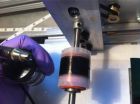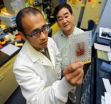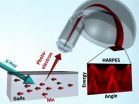(Press-News.org) Researchers from North Carolina State University have developed new techniques for stretching carbon nanotubes (CNT) and using them to create carbon composites that can be used as stronger, lighter materials in everything from airplanes to bicycles.
By stretching the CNT material before incorporating it into a composite for use in finished products, the researchers straighten the CNTs in the material, which significantly improves its tensile strength – and enhances the stiffness of the composite material and its electrical and thermal conductivity.
State-of-the-art carbon fiber composites are currently used to build airplanes and other products where strong, lightweight materials are desirable. Lighter airplanes, for example, are more fuel efficient. However, researchers have long thought that if these composites could be made with CNTs they could be just as strong, but 10 times lighter. Or they could be the same weight, but 10 times stronger.
Creating a strong CNT composite requires four features. First, it needs long CNTs, which are more effective at carrying loads. Second, the CNTs need to be aligned in rows. Third, the CNTs in the material are held together by a polymer or resin, and you need to have a high ratio of CNTs to polymer in the finished composite material. Fourth, you need the CNTs to be as straight as possible, so that the material bears weight evenly.
For decades, researchers have been unable to achieve these goals. But now a research team, led by Dr. Yuntian Zhu, a professor of materials science and engineering at NC State, has developed a solution.
"The new technique begins with a CNT array," Zhu says, "which looks like a forest of CNTs growing up out of a flat substrate." Because the aspect ratio of these CNTs is high, they are long and skinny – not rigid. That means the CNTs are leaning against each other in the array. "By grabbing the CNTs at one end of the array, we are able to pull them over onto their sides – and all of the other CNTs in the array topple in the same direction," Zhu says. This results in CNTs with good alignment.
VIDEO:
In this clip, aligned carbon nanotubes (CNTs) are wound onto a rotating spool and sprayed with a polymer solution to bind the CNTs together. This creates a ribbon-like composite material...
Click here for more information.
These aligned CNTs are then wound onto a rotating spool and sprayed with a polymer solution to bind the CNTs together. This creates a ribbon-like composite material that has a high percentage of CNTs by volume, which can in turn be used to make CNT composite structures for use in finished products like airplanes and bicycles. But that doesn't address the need to straighten the CNTs.
To straighten the CNTs, Zhu and his team stretched the CNTs as the nanotubes are being pulled onto the rotating spool. This process improves the tensile strength of the CNT composite "ribbon" by approximately 90 percent (to an average of 3.5 gigapascals) and stiffness by more than 100 percent. By straightening the CNTs, the researchers were also able to almost triple the CNT composite's thermal conductivity, to 40 watts per meter per kelvin. Electrical conductivity was increased by 50 percent to 1,230 siemens per meter.
INFORMATION:
The paper on stretching the CNTs to straighten them, "Ultrastrong, Stiff and Multifunctional Films Assembled from Superaligned Carbon Nanotubes," is published online in the inaugural issue of the journal Materials Research Letters. The research was supported, in part, by the Air Force Office of Scientific Research and the North Carolina Space Grant.
Researchers involved with the work came from NC State, Suzhou Institute of Nano-Tech and Nano-Bionics, Donghua University, Marshall Space Flight Center, Oak Ridge National Laboratory, and Los Alamos National Laboratory.
New techniques stretch carbon nanotubes, make stronger composites
2012-10-15
ELSE PRESS RELEASES FROM THIS DATE:
Aggregation of proteins in cells may result in diseases
2012-10-15
Many diseases are caused by proteins losing their natural three-dimensional structure and thus their function. In most cases, the damaged proteins are degraded by different systems in the cells, but in some cases, the proteins begin to aggregate and form very well-organised rope-like structures called fibrils. These structures have now been linked to many different diseases, such as Alzheimer's, Parkinson's, type 2 diabetes and corneal dystrophies (opaqueness in the cornea).
It has long been known that corneal dystrophy is caused by a mutation of a protein called TGFBIp ...
The Romans used Greek myths in their mosaics as symbols of civilization
2012-10-15
This press release is available in Spanish.This line of research, coordinated by Luz Neira, who is a professor in the Department of Humanities: History, Geography and Art, as well as a researcher in UC3M's Institute for Culture and Technology (Instituto de Cultura y Tecnología), continues on the path established by previous studies that examined the images of women and certain legends in Roman mosaics. "We had previously shown the memory and conscious, self-interested reuse of myths, but this new volume also examines the possibility that there is a subliminal message regarding ...
Protein could be key for drugs that promote bone growth
2012-10-15
AUGUSTA, Ga. – Georgia Health Sciences University researchers have developed a mouse that errs on the side of making bone rather than fat, which could eventually lead to better drugs to treat inflammatory diseases such as rheumatoid arthritis.
Drugs commonly used to treat those types of conditions – called glucocorticoids – work by turning down the body's anti-inflammatory response, but simultaneously turn on other pathways that lead to bone loss. The result can lead to osteoporosis and an accumulation of marrow fat, says Dr. Xingming Shi, bone biologist at the GHSU ...
Antibiotic contamination a threat to humans and the environment
2012-10-15
Researchers from the University of Gothenburg, Sweden, spend August in Sisimiut on the west coast of Greenland studying the prevalence of antibiotic resistance and the effects of antibiotic emissions on communities of bacteria living in marine sediments. More specifically, they were investigating how communities of bacteria in sediment and clay on the seabed are affected by exposure to antibiotics.
"We know very little about what happens to antibiotics that end up in the ocean, but several substances can accumulate in sediments where biodegradation occurs extremely slowly," ...
U-M, other universities launch Great Lakes protection project
2012-10-15
ANN ARBOR—The University of Michigan and 20 other U.S. and Canadian universities will join forces to propose a set of long-term research and policy priorities to help protect and restore the Great Lakes and to train the next generation of scientists, attorneys, planners and policy specialists who will study them.
The Great Lakes Futures Project of the Transborder Research University Network will use a cross-disciplinary, cross-sector approach to outlining alternative Great Lakes futures through science-based scenario analysis.
"With the recent release of the revised ...
Space station and space flight gravity influence immune system development
2012-10-15
New research findings recently published in The FASEB Journal, show that immune system development is affected by gravity changes, as reported by researchers from the University of Lorraine and University of Luxembourg. Astronauts are exposed to stresses, during launch and landing, which disrupts their body's natural defenses against infection. Changes to the immune system need to be investigated before astronauts undergo longer space missions.
Researchers looked at how antibody production is affected when animal development occurs onboard a space station and which ...
DNA method can provide more effective treatment of childhood cancer
2012-10-15
After leukaemia and brain tumours, neuroblastoma is the most common form of cancer to affect children. A thesis from the Sahlgrenska Academy, University of Gothenburg, Sweden, has studied a DNA method which is now used for all cases of neuroblastoma in Sweden, and which has led to more effective treatment at individual level.
Neuroblastoma affects around 20 children each year, most of them under the age of two. This form of cancer, which affects the peripheral nervous system, is particularly unusual: some tumours can regress spontaneously without treatment, while others ...
The tomboy in manga for teens: Kaleidoscopic bodily styles
2012-10-15
Ylva Sommerland, from the University of Gothenburg, Sweden, has studied the tomboy in manga, a girl manoeuvring in masculine situations. The study concerns sports manga and fantasy manga for teens – genres that offer plenty of tomboy stories.
The study focuses on a tomboy found in Mitsuru Adachi's sports manga Cross Game. Sports manga is immensely popular in Japan, and Mitsuru Adachi is one of the most well-known artists in this genre. He has been active since the 1970s.
"My analyses for example show that his character Aoba uses her entire female body when playing ...
Another advance on the road to spintronics
2012-10-15
Spintronic technology, in which data is processed on the basis of electron "spin" rather than charge, promises to revolutionize the computing industry with smaller, faster and more energy efficient data storage and processing. Materials drawing a lot of attention for spintronic applications are dilute magnetic semiconductors – normal semiconductors to which a small amount of magnetic atoms is added to make them ferromagnetic. Understanding the source of ferromagnetism in dilute magnetic semiconductors has been a major road-block impeding their further development and use ...
New merciful treatment method for children with brain tumors
2012-10-15
Children who undergo brain radiation therapy run a significant risk of suffering from permanent neurocognitive adverse effects. These adverse effects are due to the fact that the radiation often encounters healthy tissue. This reduces the formation of new cells, particularly in the hippocampus – the part of the brain involved in memory and learning.
Researchers at the University of Gothenburg's Sahlgrenska Academy have used a model study to test newer radiation therapy techniques which could reduce these harmful adverse effects. The researchers based their study on a ...



